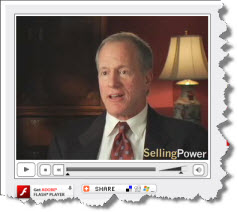 Yesterday during The Top Sales Experts Roundtable, Linda Richardson made a strong case for customized sales training. It’s not something she has to convince us at ESR about.
Yesterday during The Top Sales Experts Roundtable, Linda Richardson made a strong case for customized sales training. It’s not something she has to convince us at ESR about.
Many organizations want a customized sales training experience, whether it be live or virtual. This can be good or bad, depending upon what experiences and materials are customized, and to what degree. It’s important for sales training buyer to understand any and all customization requirements and objectives; and, it is incumbent upon that person to have an effective strategy for customization.
ESR have yet to find a client who says, “Yes, off-the-shelf training is just fine for my organization.” Every organization feels that it is unique, that its problems are unique, and that only a unique program can maximize their potential.
The Problem
When an organization brings in a sales training company, there is a challenge that the organization is trying to overcome or an opportunity to leverage.
This fundamentally implies that a change is needed—that the status quo is not sufficient to continue to propel sales growth. The sales training company is brought in to effect some change, usually a behavioral change, in the participating sales people, to stimulate that sales growth.
ESR recommends that the first place to look when considering any degree of behavioral change is your sales methodology. That’s the backbone on which all your processes, tools, training, hiring, measurement system, and sales approach will be built. Fix or replace the methodology first. If you don’t have a methodology, you will need to build one. (Training your team on how to employ that methodology eventually follows.) This is an old song, but everyone needs to hear it until they can sing along.
Change vs. Status Quo
By acknowledging the need for change, it’s important to understand the meaning of sales training program customization. There are two types of customization:
- Tailoring—adapting the training materials to reflect the sales organization’s products, services, sales force characteristics, as well as market and corporate specifics;
- Modification—altering the intellectual property of the sales training company resulting in different learnings, or modifying the instructional design of the program so that there is a core difference in the way the materials are presented.
Tailoring is almost always useful. Tailoring materials gets your company name in front of the sales people and personalizes the experience. Tailoring can replace canned, generic workshop examples with actual examples from your sales force’s existing pipeline, or recent wins or losses, personalizing the experience and maximizing the probability that the sales person will identify with the program. Tailoring, if limited to phrasing, word usage, workshops and case study examples, is often helpful.
Modification is a two-edged sword. Modification can be helpful if there are processes within your sales organization that you know factually and empirically work, and if you can separate these working best practices from those processes which you know, or suspect, may be constraining your sales growth.
The Risk of Modification
Modification carries a potential risk—LCD—”lowest common denominator.” There is an observable tendency among course and methodology modifiers, resulting from pressure from certain stakeholders, to fine tune the new methods and processes taught in the course materials to such an extent that they are “devolved” into a mere reflection of the existing, flawed sales methodology. Customizing course materials to make the program “more like our business environment” can effectively negate the original objective of the program, which was to effect behavioral change.
With that in mind, ESR has recognized some leading sales training companies for their very effective approaches to modification.
Avoiding “Devolution”
How do you avoid “devolution” in your customized sales training programs? Four considerations:
- Invest in a comprehensive, objective assessment of the performance of your sales team—know very specifically what works and what doesn’t;
- When documenting and implementing best practices, make sure that you have empirical metrics that denote that those practices do, in fact, stimulate behaviors that increase sales;
- Evaluate your sales training company’s methods for modification of educational programs;
- Stick with tailoring of your training provider’s content, assuming you’ve selected the right partner.
Number three is important. Some sales training organizations resist modification of their programs at all. Some have a core set of learnings that are assembled and designed around a study of your organization’s best practices. Others have designed proprietary systems or methodologies for modifying course materials that are specifically designed to maximize the value of nomenclature tailoring, while minimizing the probability that the structural integrity of a course will be damaged by the customization effort.
My recommendation is this: Don’t make a snap decision on either a trainer or on your customization approach. Do you have to spend all this time and effort figuring this out? Only if you want to get it right.
Source: The Value and Perils of Customized Training, an ESR/Insight™ Brief.
Photo credit: © bugman – Fotolia.com
Filed under: Measurement, Methodology, sales process, sales training, Sales Training Companies | Tagged: customized training, devolution, Linda Richardson, tailoring, Top Sales Experts | 8 Comments »










